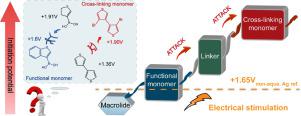Water Research ( IF 11.4 ) Pub Date : 2021-09-15 , DOI: 10.1016/j.watres.2021.117670 Yao Pan 1 , Dan Shan 2 , Li-Li Ding 1 , Xu-Dong Yang 1 , Ke Xu 1 , Hui Huang 1 , Jin-Feng Wang 1 , Hong-Qiang Ren 1

|
Our screening data revealed the threat macrolide antibiotics, especially azithromycin (AZN), posed to human health with its increasing occurrence in water environment. The electrochemical sensor based on molecularly imprinted polymer (MIP) is a promising platform that caters for the next generation of intelligent wastewater treatment plants (WWTPs) by virtue of its wide tolerance to water from all sources and in-situ monitoring. However, low initiation potentials of cross-linking monomers contributed by the electron-rich circumstance allowed them to usurp sites designed for functional monomers when electrically stimulated, leading to an unsatisfactory binding capacity. Another uncertainty is that multiple reaction sites of cross-linking monomers granted them complex polymerization routes and made it difficult to ensure the consistency of preparation. Serval monomers had been investigated with electrochemical tools and the performance of sensors constructed with these monomers were compared in this study. Based on the results, we proposed a protocol in which a novel functional monomer possessing a stronger electron-donating group, phenyl, was adopted to compete for the dominance in electropolymerization. Beyond that, the cross-linking monomer was modified with electron-withdrawing groups to raise its initiation potential. A monothiophene with a moderate initiation potential was also recruited as the linker to address the steric hindrance. In this way, polymerization proceeded in a specific order. It is worth mentioning that the Marangoni flow is an ideal tool to deal with the Coffee-ring deposition while drop-casting. The resulting sensor showed good performance with a limitation of detection (LOD) of 0.120 μM for AZN and a satisfactory selectivity, and the design can be applied to constructing sensors for a variety of macrolide antibiotics.
中文翻译:

开发一种普遍适用的电化学传感器,用噻吩基分子印迹聚合物检测水中的大环内酯
我们的筛选数据揭示了大环内酯类抗生素,尤其是阿奇霉素 (AZN),其在水环境中的出现率越来越高,对人类健康构成了威胁。基于分子印迹聚合物 (MIP) 的电化学传感器是一个有前途的平台,凭借其对所有来源和原位水的广泛耐受性,可满足下一代智能污水处理厂 (WWTP) 的需求。监测。然而,由富电子环境贡献的交联单体的低引发电位允许它们在电刺激时篡夺为功能单体设计的位点,导致不令人满意的结合能力。另一个不确定性是交联单体的多个反应位点赋予它们复杂的聚合路线,并且难以确保制备的一致性。使用电化学工具对薮猫单体进行了研究,并在本研究中比较了用这些单体构建的传感器的性能。基于这些结果,我们提出了一种方案,其中采用具有更强给电子基团苯基的新型功能单体来竞争电聚合的主导地位。除此之外,交联单体用吸电子基团改性以提高其引发电位。还招募了具有中等起始潜力的单噻吩作为接头来解决空间位阻问题。这样,聚合按特定顺序进行。值得一提的是,Marangoni 流是处理滴铸时咖啡环沉积的理想工具。所得传感器表现出良好的性能,对 AZN 的检测限 (LOD) 为 0.120 μM,并且具有令人满意的选择性,该设计可用于构建各种大环内酯类抗生素的传感器。聚合按特定顺序进行。值得一提的是,Marangoni 流是处理滴铸时咖啡环沉积的理想工具。所得传感器表现出良好的性能,对 AZN 的检测限 (LOD) 为 0.120 μM,并且具有令人满意的选择性,该设计可用于构建各种大环内酯类抗生素的传感器。聚合按特定顺序进行。值得一提的是,Marangoni 流是处理滴铸时咖啡环沉积的理想工具。所得传感器表现出良好的性能,对 AZN 的检测限 (LOD) 为 0.120 μM,并且具有令人满意的选择性,该设计可用于构建各种大环内酯类抗生素的传感器。











































 京公网安备 11010802027423号
京公网安备 11010802027423号